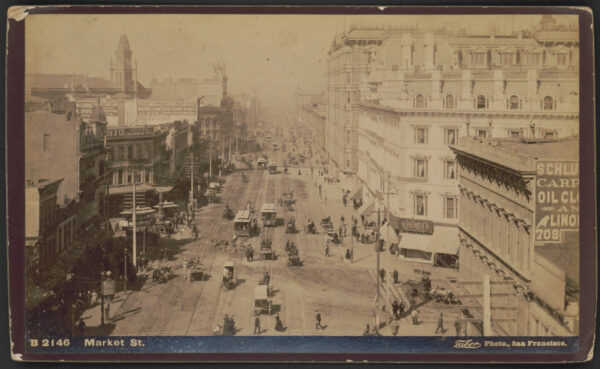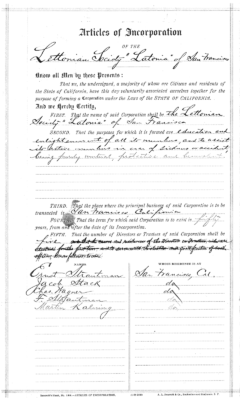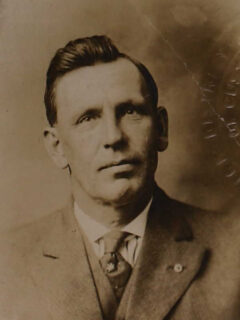
On the first Saturday of November 1897, a group of Latvians gathered in an apartment on Natoma Street in downtown San Francisco. Their goal was to elect five members to the board of the newly formed Lettonian Society “Latonia” of San Francisco — the first Latvian organization on the west coast of the United States.
Little is known of this organization other than what appears in its articles of incorporation and a few scattered references in periodicals of the late 19th and early 20th centuries.

Like similar immigrant organizations, Latonia had a goal of “education and enlightenment of all its members, and to assist its active members in case of sickness or accident, being purely mutual, protective and benevolent.”1
It had a short life. According to Ernests Minka, who wrote about California’s Latvians 35 years later in an article for the Rīga newspaper Latvijas Sargs, the society was liquidated in 1898 and the money in its treasury sent to London to support publication of Latvian literature abroad.2 At the time, a number of Latvian socialdemocrats in London were organizing to print and distribute revolutionary literature, which might also suggest the political leanings of Latonia’s members.
However, officially the organization’s registration with the state of California expired 50 years later, on November 19, 1947.
The five men elected to the board of directors — Martin Kalning, Jacob Stack, Ernst Strautman, F(rederick) Strautman, and Charles Wagner — most likely worked as sailors, as did most if not all of the more than dozen Latvians who called 16 Natoma Street home while in San Francisco. Stack was listed in the articles of incorporation as the society’s vice president, while another man, John Kruhming, was named secretary.
Latvians had settled in San Francisco already by the early 1880s, as historian Elga Zālīte has shown, although little documentation exists of their presence.3 One immigrant’s letter to an acquaintance in the homeland appeared in a March 1888 edition of the newspaper Latviešu Avīzes. “San Francisco is almost two times as large as Rīga,” he wrote, “with more than 300 thousand inhabitants. Here there are different peoples — except, I think, here there is no other Latvian but for me.” The writer may not have been aware of the Latvian sailors who passed through the city.4 However, another Latvian in America, offering advice to those in the homeland who might want to emigrate, that same year mentioned San Francisco as one of several cities where their countrymen could be found.5
Of the men known to have been involved with the Latonia society, most remained in California.

Martin Kalning (in Latvian, Mārtiņš Kalniņš) stayed in the San Francisco area years after the founding of the Latonia society. He was born in 1874 in Rīga, started his career as a sailor in 1889, and became a naturalized U.S. citizen in 1898. By the time of the 1910 federal census, he was married to Florence and had two daughters. As late as 1929 he was still working aboard ships, according to government documents.6
John Kruhming (Jānis Krūmiņš) immigrated to the U.S. in 1887 and became a naturalized citizen in 1892.7 According to the 1920 federal census, he worked as a clerk in a boarding house. He died in May 1922 at age 55, according to the California Death Index and funeral home records.
Jacob Stack (perhaps Jēkabs Stāks) was born in 1863 and came to the U.S. in 1889 as a mariner, according to the 1910 federal census. He was killed by an automobile on December 13, 1914. At the time of his death, the 51-year-old Stack was working as a bartender, according to his funeral home record.
Ernst Strautman (Ernests Strautmanis) and Frederick Strautman (perhaps Fricis Strautmanis) may have been brothers.
Ernst Strautman was born in 1856 and arrived in the U.S. as a mariner in 1887. He did not stay long in San Francisco. By 1901, he had moved to Bainbridge Island, west across the Puget Sound from Seattle, Washington. Bainbridge Island by the turn of the century was home to a handful of Latvians. There, he married Elizabeth (Lizzie) Eglit, a Latvian immigrant from Brooklyn, New York.8 Strautman died in 1918, according to the Washington Department of Health’s death index.
Frederick Strautman, born about 1864, in 1898 lived at the same address in San Francisco as Jacob Stack, according to California voter registration records. He, too, was a mariner.
Charles Wagner’s (perhaps Kārlis Vāgners) biography remains unclear.
Not until 1905 would Latvians in San Francisco again attempt to organize. That year, a section of the Lettish Federation of the Socialist Labor Party was established. This was followed in 1906 by formation of the Lettish Social-Democratic Society of San Francisco, whose members were mostly newly arrived immigrants who had been radicalized by the 1905 Revolution.
1. Lettonian Society Latonia of San Francisco, “Articles of Incorporation,” November 11, 1897. See also Amerikas Vēstnesis, August 1896, p. 12, wherein a correspondent (likely either Ernest or Frederick Strautman) reported on the founding of the Latonia society — more than a year before its formal incorporation.
2. E. Minka, “Latvieši zelta leģenda zemē,” Latvijas Sargs, July 17, 1933, p. 3. While Minka reported that the society had disbanded the year after its founding, an historian in Latvia later suggested that Latonia continued to operate and that in 1907 it published a periodical, Žurnāls. However, no evidence has been found to confirm this claim by J. Hartmanis, “Tālie ceļi, tālais laiks,” Cīņa, August 17, 1988, p. 3. In her study of the library of the city’s Latvian socialists, no mention of either the society or of a publication produced by it is made by Elga Zālīte, “Exploring the Library of Latvian Socialists in San Francisco, California: Activities of the Early Latvian Political Emigration, 1905-1917,” Latvijas Vēstures Institūta Žurnāls 2:91(2014), pp. 9-92. The society merits just one sentence in Raimonds G. Slaidiņš, ed., Latvieši Sanfrancisko un tās apkārtnē (San Francisco: Ziemeļkalifornijas latviešu biedrība, 2011), p. 15. See also K.I., “Par latviešu pēdām Rietumu piekrastē,” Laiks, November 10, 1954, p. 6.
3. Zālīte, p. 18, discovered several immigrants who arrived in the period 1880-1883.
4. “Iz Amerikas,” Latviešu Avīzes, March 23, 1888, p. 2.
5. “Izskaidrojumi un atbildes par Ameriku no J. Fišera,” Latviešu Avīzes, September 21, 1888, p. 4.
6. Ancestry.com. U.S., Merchant Marine Applications for License of Officers, 1914-1949 [database on-line]. Provo, UT, USA: Ancestry.com Operations, Inc., 2015. See also Ancestry.com. U.S., Applications for Seaman’s Protection Certificates, 1916-1940 [database on-line]. Provo, UT, USA: Ancestry.com Operations, Inc., 2010.
7. “California, San Francisco County Records, 1824-1997,” database with images, FamilySearch (https://familysearch.org/ark:/61903/3:1:33S7-956G-9K3G?cc=1402856&wc=3195-FM3%3A20726401%2C24098501 : 20 May 2014), Naturalization and Citizenship > Naturalization Supplement Index, K-Z, 1873-1926 > image 20 of 412; San Francisco Public Library.
8. Ancestry.com. Washington, Marriage Records, 1854-2013 [database on-line]. Provo, UT, USA: Ancestry.com Operations, Inc., 2012.
Accessed on 20 Apr 2024.
The article may be found online at https://straumanis.com/2018/latonia-society/.
